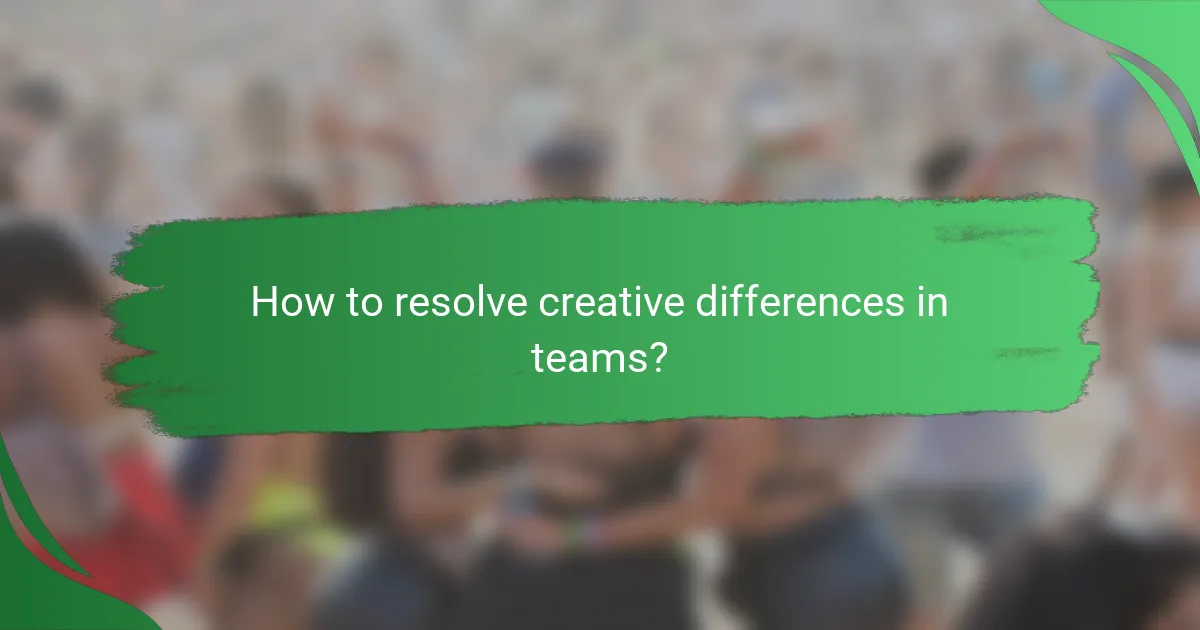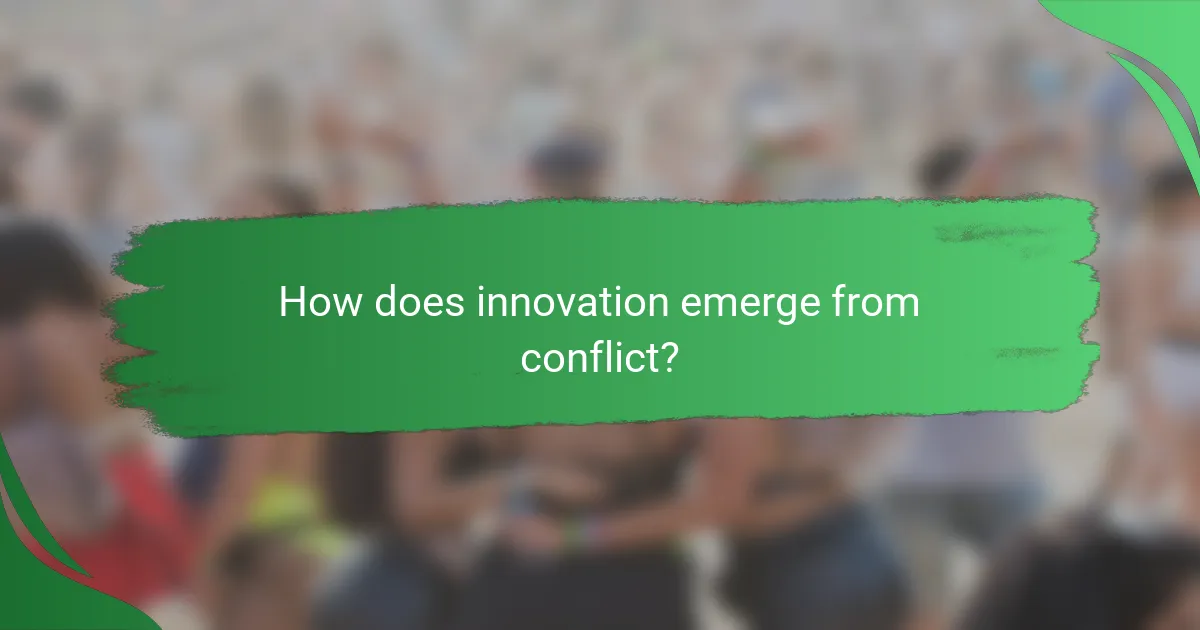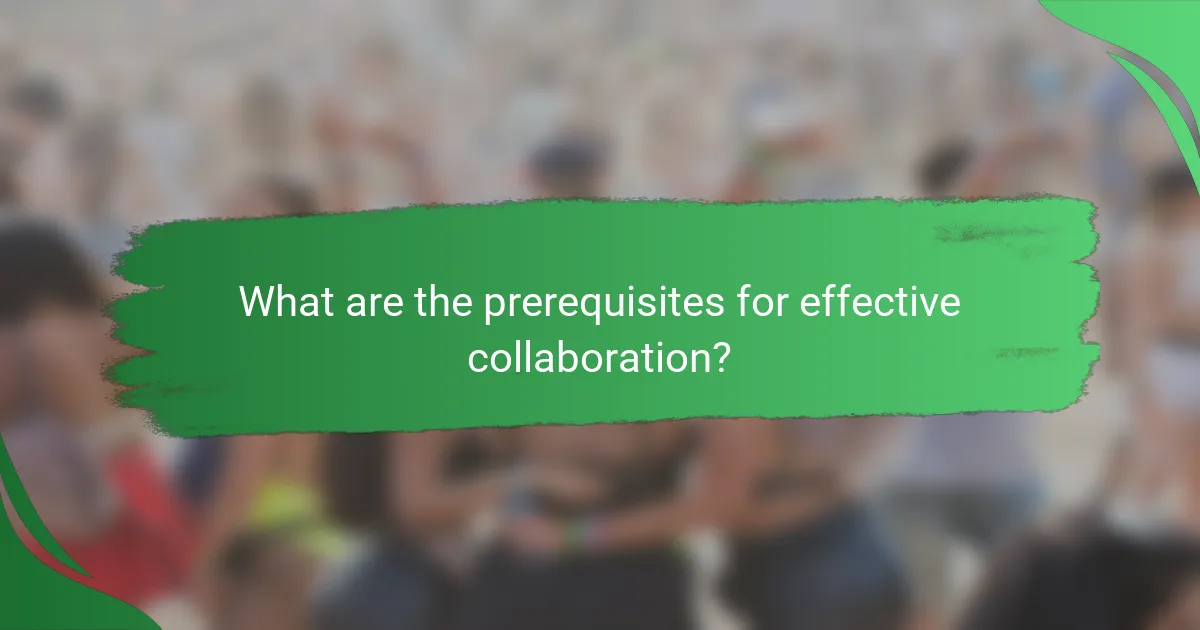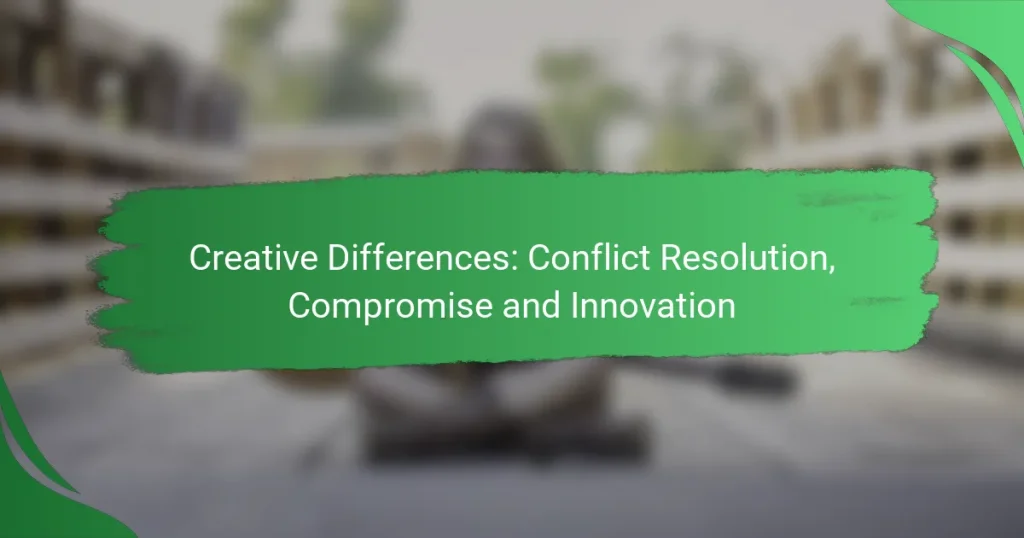Creative differences can be a catalyst for innovation, but they also require careful management to ensure productive outcomes. By fostering open communication and utilizing effective compromise techniques, teams can navigate conflicts and turn diverse perspectives into collaborative solutions. Embracing these differences not only resolves disputes but also encourages the exploration of new ideas that can lead to significant breakthroughs.

How to resolve creative differences in teams?
Resolving creative differences in teams involves fostering an environment where diverse ideas can be shared and discussed openly. Effective resolution requires a combination of communication, facilitation, and structured frameworks to guide discussions toward productive outcomes.
Open communication strategies
Open communication is essential for addressing creative differences. Encourage team members to express their thoughts and feelings without fear of judgment. Regular check-ins and brainstorming sessions can help create a safe space for sharing ideas.
Utilize active listening techniques, where team members repeat back what they’ve heard to ensure understanding. This not only clarifies points but also shows respect for differing opinions, which can reduce tension and foster collaboration.
Facilitation techniques
Effective facilitation can help navigate creative differences by guiding discussions and keeping them focused. A neutral facilitator can manage the conversation, ensuring everyone has a chance to contribute while preventing dominant voices from overshadowing others.
Techniques such as round-robin sharing, where each person speaks in turn, can help balance participation. Additionally, using visual aids like whiteboards or sticky notes can help organize thoughts and encourage collective problem-solving.
Conflict resolution frameworks
Implementing a structured conflict resolution framework can streamline the process of resolving creative differences. The interest-based relational approach focuses on understanding the needs and interests of all parties involved, rather than just the positions they hold.
Another effective framework is the Thomas-Kilmann Conflict Mode Instrument, which identifies five conflict-handling modes: competing, collaborating, compromising, avoiding, and accommodating. Teams can benefit from discussing which mode is most appropriate for their situation, helping to align their approach to resolving differences.

What are effective compromise techniques?
Effective compromise techniques involve strategies that facilitate negotiation and collaboration to reach mutually acceptable solutions. These methods help parties navigate conflicts by balancing differing interests and fostering innovation through shared ideas.
Negotiation skills
Negotiation skills are essential for achieving effective compromises. Key techniques include active listening, where parties fully engage with each other’s viewpoints, and clear communication, which ensures that all concerns are articulated. Practicing these skills can lead to more productive discussions and better outcomes.
One effective approach is to prepare a list of priorities before negotiations begin. This allows each party to understand their non-negotiables and areas where they can be flexible. For instance, if two teams are debating project timelines, one might prioritize speed while the other values thoroughness, leading to a balanced compromise.
Collaborative decision-making
Collaborative decision-making involves all stakeholders working together to identify solutions that satisfy everyone involved. This technique encourages open dialogue and collective brainstorming, which can lead to innovative outcomes that might not emerge in a more adversarial setting.
To implement collaborative decision-making, establish ground rules for discussions, such as respecting differing opinions and focusing on problem-solving rather than blame. Utilizing tools like brainstorming sessions or workshops can also enhance participation and creativity, ensuring that all voices are heard.
Consensus-building methods
Consensus-building methods aim to create agreement among all parties, fostering a sense of ownership over the final decision. Techniques such as the Delphi method, where feedback is gathered anonymously and iteratively, can help in reaching a consensus without direct confrontation.
Another effective strategy is to use a “fist to five” voting system, where participants indicate their level of support for a proposal. This visual representation of agreement can quickly highlight areas of concern and facilitate discussions to address them, leading to a more unified decision-making process.

How does innovation emerge from conflict?
Innovation often arises from conflict as differing viewpoints challenge the status quo, prompting creative solutions. When individuals or teams confront disagreements, they are pushed to explore new ideas, leading to breakthroughs that may not have occurred in a more harmonious environment.
Case studies of successful innovation
Numerous organizations have turned conflict into a catalyst for innovation. For example, the tech giant Apple famously thrived on internal disagreements, particularly between Steve Jobs and his team, which led to the development of groundbreaking products like the iPhone. Similarly, Pixar’s collaborative environment encourages creative tension, resulting in award-winning films.
Another notable case is the automotive industry, where companies like Ford and Tesla have faced intense competition. These rivalries have driven advancements in electric vehicles and autonomous driving technologies, showcasing how conflict can lead to significant innovations.
Role of diverse perspectives
Diverse perspectives are crucial in transforming conflict into innovation. When team members bring varied backgrounds, experiences, and viewpoints, they can challenge each other’s assumptions and spark new ideas. This diversity fosters an environment where creative solutions can flourish, as individuals feel empowered to voice their opinions.
In practice, organizations can benefit from forming cross-functional teams that include members from different departments. This approach not only enhances creativity but also helps in identifying potential pitfalls early in the development process, ultimately leading to more robust innovations.
Creative problem-solving approaches
Effective creative problem-solving techniques can help navigate conflicts and drive innovation. Techniques such as brainstorming, design thinking, and the Six Thinking Hats method encourage teams to explore multiple angles of a problem, facilitating a deeper understanding of the issues at hand.
Additionally, employing structured conflict resolution strategies, like interest-based relational (IBR) approaches, can help teams focus on mutual goals rather than personal disagreements. This method promotes collaboration and can lead to innovative solutions that satisfy all parties involved.

What are the prerequisites for effective collaboration?
Effective collaboration requires a foundation of mutual understanding, trust, and clear objectives among team members. When these prerequisites are met, teams can navigate creative differences and enhance innovation through productive conflict resolution.
Team dynamics assessment
Assessing team dynamics involves understanding the roles, strengths, and weaknesses of each member. This evaluation can help identify potential conflicts and areas for improvement, ensuring that everyone contributes effectively to the group’s goals.
Consider using tools like personality assessments or team-building exercises to gain insights into how members interact. Regular check-ins can also help monitor dynamics and adjust strategies as needed.
Building trust and rapport
Building trust and rapport is essential for fostering open communication and collaboration. Team members should engage in activities that promote personal connections, such as team lunches or collaborative projects that allow for shared experiences.
Encouraging transparency and vulnerability can also strengthen relationships. For instance, sharing individual challenges or successes can create a supportive environment where team members feel valued and understood.
Setting clear goals
Clear goals provide direction and purpose for collaboration. Establishing specific, measurable, achievable, relevant, and time-bound (SMART) objectives can help align team efforts and clarify expectations.
Regularly revisiting and adjusting these goals ensures that the team remains focused and adaptable. Consider using project management tools to track progress and facilitate communication regarding goal attainment.

How to measure the impact of conflict resolution?
Measuring the impact of conflict resolution involves assessing improvements in team dynamics, productivity, and overall morale. Effective metrics can provide insights into how well conflicts are managed and the subsequent effects on innovation and collaboration.
Performance metrics
Performance metrics can include productivity rates, project completion times, and quality of work. For example, tracking the number of projects completed on time before and after implementing conflict resolution strategies can highlight improvements. Additionally, measuring employee turnover rates can indicate how well conflicts are resolved and whether team members feel valued.
Consider using a balanced scorecard approach to evaluate multiple dimensions of performance, such as financial outcomes, customer satisfaction, and internal processes. This comprehensive view helps ensure that conflict resolution efforts align with broader organizational goals.
Feedback mechanisms
Implementing feedback mechanisms is crucial for understanding the effectiveness of conflict resolution. Regular surveys or one-on-one interviews can provide insights into team members’ perceptions of conflict management processes. Anonymity can encourage honest feedback, leading to more accurate assessments.
Additionally, establishing a system for ongoing feedback can help identify areas for improvement. For instance, consider using a simple rating scale (e.g., 1 to 5) to gauge team members’ satisfaction with conflict resolution outcomes. This data can inform future strategies and enhance team cohesion.


